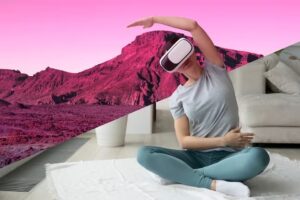Mixed Reality (MR) represents an advanced integration of both Augmented Reality (AR) and Virtual Reality (VR), poised to redefine our interactive experiences with the world. This exploration details how MR builds upon AR’s foundation, offering a more immersive interaction across various applications.
Defining Augmented Reality
Augmented Reality (AR) is a technology that superimposes digital data, like images, videos, or 3D models, onto the physical world. It utilizes computer vision, sensors, and cameras for integrating virtual components seamlessly into real-world settings. AR amplifies our interaction with the physical world by adding virtual elements that coexist with our surroundings. Common AR applications include social media filters and immersive gaming, enriching our reality without completely replacing it.
Understanding Mixed Reality
Mixed Reality (MR) elevates the concept of AR by harmoniously blending virtual elements into the physical environment, fostering an immersive interaction. MR headsets map the user’s environment in real-time, allowing virtual elements to respond naturally to physical barriers and user interaction. This technology finds applications in diverse fields, from architecture to medicine, offering realistic experiences where the physical and virtual worlds converge.
Comparative Analysis: AR vs. MR
While AR and MR blend virtual elements with the real world, they differ notably. AR overlays virtual content onto reality, enhancing but not replacing the physical environment. Conversely, MR integrates virtual content more deeply, creating a more immersive experience where virtual and real worlds interact dynamically.
| Aspect | Augmented Reality (AR) | Mixed Reality (MR) |
|---|---|---|
| Definition | Superimposes digital information onto the real world. | Blends digital and real-world elements seamlessly. |
| User Interaction | Enhances real environments with virtual overlays. | Enables interaction between virtual objects and real-world environments. |
| Technology Use | Uses cameras and sensors to overlay virtual content. | Employs advanced sensors and headsets for a deeper integration of virtual content. |
| Immersion Level | Partial immersion with a focus on enhancing reality. | Full immersion, creating a hybrid of real and virtual worlds. |
| Applications | Social media filters, gaming, navigation, and retail. | Advanced gaming, architectural visualization, medical training, and more. |
| Hardware Requirement | Generally requires a smartphone or tablet. | Often necessitates specialized MR headsets and equipment. |
| User Experience | Limited to viewing virtual elements in physical spaces. | Users can interact with virtual elements as if they were real. |
| Potential for Industry | Broad application across various sectors. | More targeted towards industries requiring detailed visualization and interaction. |
Advantages of Mixed Reality Over Augmented Reality
MR transcends AR by offering a deeply integrated and interactive experience. Virtual objects in MR can interact with real-world obstacles, offering a heightened sense of realism. This advanced interaction enables more intricate engagements with virtual objects, paving the way for innovative applications in various sectors.
Challenges in Implementing Mixed Reality
Implementing MR involves overcoming hardware limitations, developing realistic virtual content, integrating technology into existing systems, and addressing privacy and security concerns. Despite these challenges, MR’s potential benefits make it a compelling field for further development.
Exploring the Future Potential of Mixed Reality
The future of MR is promising, with vast potential across education, healthcare, entertainment, and architecture. It offers immersive learning experiences, advanced medical training, novel entertainment options, and enhanced design and architectural visualization. The continuous evolution of MR technology heralds a future where MR becomes an integral part of our daily lives.
Video Guide
To answer all your questions, we have prepared a video for you. Enjoy watching it!
How to Buy NFT Art Finance
In the context of discussing augmented and mixed realities, it’s crucial to also understand the burgeoning world of NFTs (Non-Fungible Tokens), particularly in the art sector. NFT Art Finance is a key player in this space, offering unique opportunities for investment and collection. This section provides a comprehensive guide on how to purchase NFT Art Finance, blending the worlds of cryptocurrency, art, and advanced reality technologies.
Conclusion
In summary, the evolution from Augmented Reality (AR) to Mixed Reality (MR) marks a significant leap in how we interact with digital content within our physical world. While AR offers an enhanced view of reality by overlaying digital information onto our environment, MR takes a bold step further by integrating these virtual elements more deeply, creating a more immersive and interactive experience.
The comparative analysis reveals that MR provides a heightened sense of realism and engagement. This is particularly evident in applications requiring intricate interaction with digital content, such as in medical training, architectural design, and immersive gaming. The requirement for specialized equipment in MR, compared to the more accessible AR technology, points to a trade-off between complexity and immersion.
As we venture further into this technological frontier, the lines between physical and digital realities continue to blur. This progression opens up exciting possibilities and challenges, suggesting a future where our interaction with technology becomes more seamless and integrated into our daily lives. The journey from AR to MR is not just about technological advancement, but also about reimagining and expanding our experiences and interactions within an increasingly digital world.


Average Rating